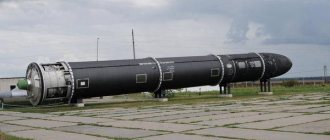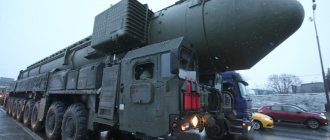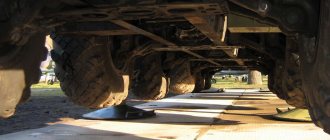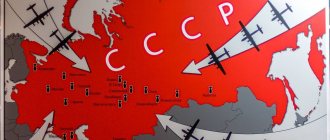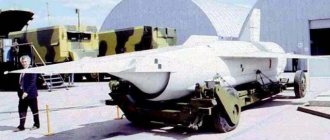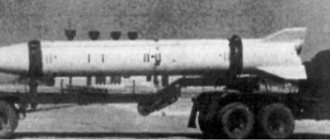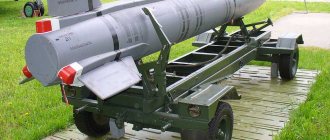R-5M rocket: the firstborn of the nuclear missile era
On February 2, 1956, for the first time in world history, a ballistic missile with an atomic warhead took flight.
In the history of the Russian armed forces, there were two famous operations called “Baikal”. One of them, “Baikal-79,” became known almost immediately to the whole world: this was the name of the operation to overthrow the regime of Hafizullah Amin in Afghanistan on December 27, 1979. Even in the USSR, few people knew about the second, simply called “Baikal” - only those who were directly related to the organization and conduct of this operation. Meanwhile, it is from this point that the beginning of the nuclear missile era should be counted. On February 2, 1956, an R-5M missile with a nuclear warhead was launched from the Kapustin Yar test site towards the Karakum Desert - for the first time not only in our country, but also in the world.
Having flown an estimated distance of 1,200 kilometers, the missile hit the target, albeit with almost extreme deviation. The fuse went off, a chain reaction began - and a characteristic atomic mushroom appeared at the site of the impact. Foreign means of monitoring nuclear tests in the Soviet Union, of course, noted this fact, even calculating the power of the detonated charge - 80 kilotons of TNT. But no one abroad could have imagined that this was not just a test, but a test of the world’s first ballistic missile with a nuclear charge...
Combat crew of the R-5M missile. Photo from the Ministry of Defense publication “Kapustin Yar Test Site. 70 years of testing and launches. Declassified photographs"
The birth of the "five"
The R-5M rocket owes its birth, ultimately, to the failure that befell Sergei Korolev and his rocket scientists while working on the R-3 rocket. However, the developers themselves were not to blame for this: both then and now the prevailing point of view was that in the conditions of the mid-1950s there was no chance of success in creating a ballistic missile with a flight range of 3000 kilometers. There was simply no experience, no materials, no equipment to create oxygen-kerosene engines that could throw a warhead over such a distance.
The “Troika” never made it to the start line, but became the progenitor of the “Five”. Work on the R-5 rocket began immediately after the developers decided to abandon the development of the experimental R-3 before testing began. By October 30, 1951, the preliminary design of the R-5 was ready. Those who understood the rocket technology of that time understood well that the appearance of the new BRDD, that is, a long-range ballistic missile, contained the features of all its predecessors - the R-1, and the R-2, and of course the R-3. But at the same time, there were significant differences that made it possible to bring the project of the first domestic ballistic missile with a nuclear warhead to fruition. In particular, the hermetic instrument compartment disappeared from it, which resulted in significant weight savings, the appearance of the head part changed, and most importantly, the designers abandoned the thermal insulation of the oxygen compartment. Yes, because of this, it was necessary to replenish the oxidizer supply before the start, but again the weight was reduced, which means the range increased - which, in fact, was what needed to be achieved.
The government decree on the start of development work on the “five” was issued on February 13, 1952. And exactly a year later, a new resolution of the USSR Council of Ministers appeared - already on conducting flight design tests of the R-5. The first launch of the “five” from the Kapustin Yar training ground took place on March 15, 1953, and the last ones in February 1955. A total of 34 missiles were launched, and only three launches from the first series of tests were unsuccessful. The groundwork for the first 12 production missiles was already ready, work on them had already begun - but then the project was stopped. A government decree of April 16, 1955 declared work on the R-5 completed, serial production was ordered to be curtailed, and all efforts were redirected to creating a modernized R-5 with a nuclear warhead.
Soviet DAR
The Five was good for everyone, except for one thing: it carried a conventional warhead with a maximum warhead of one ton of explosives. Meanwhile, by this time it had become absolutely clear that in the context of the flaring up Cold War, the one who could create a missile with a nuclear warhead would have an advantage over the opposing side. And such people were found in the Soviet Union.
The idea of equipping the rocket with an atomic warhead was put forward by the rocket scientists themselves, and Soviet nuclear scientists were entrusted with implementing their idea. And they completely coped with this task: already in October 1953, when the R-5 was just beginning a series of tests, representatives of KB-11 - the current Russian Federal Nuclear Power Plant, and then the main creator of the USSR atomic shield - proposed using the new RDS-munition. 4 as a warhead for the "fives". And on December 17 of the same year, work to implement this proposal was approved by another government decree.
This development was named DAR - “Long-Range Atomic Rocket”. And the first mention of the R-5M rocket appeared six months later, in April 1954. By this time, work on the new product was already in full swing both at NII-88 near Moscow and at KB-11 in Nizhny Novgorod. Indeed, according to the original plans, testing of the modernized “five” was supposed to begin in October of the same year, and end with test launches and state tests - including with a nuclear warhead! - in November 1955. But as always, reality made its own adjustments to these deadlines. The R-5M entered state testing only in January 1956. By the same time, the first nuclear weapon was ready, which the new missile was to throw at a distance of 1200 kilometers.
Preparing the R-5M rocket for launch at the Kapustin Yar test site. Photo from defendingrussia.ru
“We observed Baikal!”
But before putting the world’s first ballistic missile with a nuclear warhead on the launch pad, it was necessary to test all the subtleties of docking the “special product” with the carrier. To do this, they used mock-ups of a nuclear warhead - and they carried out the first four launches as part of state tests. The first took place on January 11, 1956. The rocket safely flew its intended distance and just as safely hit the target within the “dispersion ellipse” - that is, it did not deviate too much from the given course and from the planned landing site.
This result greatly inspired the developers. After all, it confirmed not only the correctness of the chosen decision to equip the rocket with a shorter and blunter nose, which was what the gunsmiths insisted on, who needed to ensure that the rocket’s approach to the ground was not too high. First of all, the successful launch proved that the seriously complicated control system of the R-5M, in which almost all elements were duplicated, and some twice, worked without serious failures. But there were some hiccups, although they did not have a serious impact on the results of the launch. However, the discovered air flutter of the rudders forced the developers to take urgent measures, and on the next rockets the design of the rudders was partially changed, and their control system was made more rigid.
It is noteworthy that in order to ensure the reliability of the duplicated control systems, some important elements were specially “damaged” on the next three rockets before launch. And nothing! Like the first “state” R-5M, the next three also took off without failure and hit the target. And this meant that we could finally begin the last, most important stage of testing - the launch of a rocket with a real nuclear warhead, albeit of reduced power.
Launch of the R-5M rocket at the Kapustin Yar test site. Photo from the RSC Energia website
One of the founders of the domestic rocket industry, Academician Boris Chertok, spoke well about the conditions in which these tests took place in his book “Rockets and People”. Here's what he wrote: “Korolev was nervous about the delays in preparing the rocket. He did not want to allow Nikolai Pavlov (Deputy Head of the Main Directorate for the Design and Testing of Atomic Ammunition of the Ministry of Medium Machine Building. - Author's note) to report to Mitrofan Nedelin (at that moment - Deputy Minister of Defense of the USSR for Special Weapons and rocketry - author's note), to the Chairman of the State Commission that the charge is prepared for removal, and the launch delay is the fault of the rocket scientists. As a deputy technical manager, I was responsible for preparing the rocket in a technical position. <…> At night I reported to Korolev that there was a notice during the tests of the stabilization machine, I propose replacing the amplifier-converter and repeating the horizontal tests, which will require another three to four hours. He replied: “Work calmly. Their neutron gun also failed.” My knowledge of nuclear technology was not enough to realize what a gain in time we get. Finally, everything is ready and the start date of February 2 is confirmed. Everyone except the combat crew was removed from the start.”
The first in the country - and in the world! — the launch of a ballistic missile with a nuclear warhead was named “Baikal”. Apparently, as was customary at that time and in that industry, the name was chosen based on the fact that it was as little as possible associated with the location of the tests. Just in case: you never know, who and to whom will accidentally spill the beans about “Baikal” - so let the intelligence of a potential enemy look for who knows what in the Siberian taiga! But the name of the operation was also a code word with which observers had to confirm that the rocket launched from the Kapustin Yar test site reached the crash site in the Aral Karakum Desert and that the warhead worked as expected. And therefore, the test participants, all on nerves, waited and could not wait until the report “Baikal was observed” was finally heard on the telephone receiver...
And again, a quote from the memoirs of Boris Chertok: “The launch took place without any hiccups. The R-5M rocket was the first in the world to carry a warhead with an atomic charge through space. Having flown the required 1200 km, the head reached the Earth in the Aral Karakum region without destruction. The impact fuse went off and a ground-based nuclear explosion marked the beginning of the nuclear missile era in human history. There were no publications regarding this historical event. American technology did not have means of detecting missile launches. Therefore, the fact of the atomic explosion was noted by them as another ground test of atomic weapons. We congratulated each other and destroyed the entire stock of champagne, which had previously been carefully guarded in the buffet of the management staff’s dining room.”
"Ivanhoe" remained silent
But there was one more code word that accompanied the world's first test of a ballistic missile with a nuclear warhead - and which, unlike Baikal, no one wanted to hear. Unlike the first four missiles, the fifth one, with real special ammunition, was equipped with missile detonation equipment - APR. It had to be created based on the fact that a rocket equipped with a nuclear warhead, in the event of deviation from course or engine failure, poses a much greater danger than a rocket with conventional explosives. Even an option was allowed in which, in the event of combat use in the event of a technical failure, the missile could fall on its own territory, and not on the enemy’s territory - and it was necessary to develop and test a system for its destruction before the special warhead was triggered.
A word from one of Sergei Korolev’s closest associates, Refat Appazov, who took part in Operation Baikal and was responsible for the brand new APR installed on the R-5M missile. The professor spoke about the emotions he experienced on February 2, 1956 in his book of memoirs, “Traces in the Heart and in Memory”: “The launch day could have been postponed if weather conditions did not allow confident observation from the APR point. But the weather forecasters' forecast turned out to be accurate: the sky was clear, a slight frost helped maintain a cheerful fighting mood. <…> The situation was more tense than during the preparation of conventional missiles; there was almost no noticeable extraneous talk or unnecessary beating around the bush. Sergei Pavlovich, as always, called first one or the other with his usual movement, gave instructions, asked final questions, asked if there were any doubts, asked to immediately report on the slightest problems noticed. At the pre-launch meeting of the State Commission, the heads of all services of the test site and rocket systems reported on full readiness, and a decision was made to launch the rocket.
An hour before the launch, our APR (emergency rocket detonation) crew left for their workplace, but before that, one very narrow meeting took place, consisting of only three people, the participants of which were told a password word, upon uttering which the rocket was supposed to be detonated. That word turned out to be “Ivanhoe.” Why exactly this word, who chose it and what relation this medieval knight had to the upcoming work - I never found out. Most likely, it was the fantasy of Sergei Pavlovich himself, or his deputy for testing, Leonid Voskresensky, a man with very extraordinary thinking. <…> The scheme for activating the APR system was as follows. When dangerous deviations appeared, I uttered a password word, the telephone operator immediately repeated it into the receiver that connected our point with the bunker, and in the bunker L.A. Voskresensky pressed the button that transmitted this command via a radio communication line to the flying rocket. I don’t know about the others, but I felt very strong excitement, apparently realizing my special role in the upcoming operation. I’ll be honest, I was a little scared...”
Photo from the site militaryrussia.ru
But Ivanhoe remained silent: the missile almost did not deviate from its intended target. Refat Appazov remembers: “One hundred and fifteen,” I hear the timekeeper’s voice and think: “It’s going to end soon.” “One hundred and twenty,” and here is the long-awaited moment: the engine is turned off, the light in the field of view of the theodolite goes out. You can breathe, move, talk. Having looked away from the theodolite, the first thing I did was wipe off my glasses. We shook hands, congratulated each other on our success and began to wait for the transport that would take us to the start. <…> As soon as we arrived at the place, he (Sergei Korolev - Author's note) took me a little aside from his large entourage and asked how far from the target the warhead could deviate. I replied that everything should be within the dispersion ellipse, since there were no noticeable abnormalities in the flight.”
Russian "Sly"
Successful completion of state tests is, as a rule, sufficient grounds for a new model to be adopted for service. This happened with the R-5M missile: by a decree of the USSR Council of Ministers of June 21, 1956, the world's first ballistic missile with a nuclear warhead (GRAU index - 8K51, initially - 8A62M) was adopted by the engineering brigades of the Reserve of the Supreme High Command - as they were called at that time units of the future Strategic Missile Forces. However, this document only recorded the status quo, since the first unit, armed with the modernized “fives,” went on combat duty back in May.
The world learned about the appearance of a new, unprecedented weapon in the Soviet Union in the fall of 1957. On November 7, several transport units with R-5M took part in the parade on the occasion of the 40th anniversary of the October Revolution - this is how, according to tradition, the Soviet leadership demonstrated new types of weapons to foreign diplomats. The impressively sized rockets (length - 20.8 m, diameter - 1.65 m, launch weight - 29.1 tons) drove across Red Square, convincing the world that the Soviet Army has the strongest means of delivering atomic weapons. The new product received the NATO index Shyster - that is, a sly, a crook, a lawyer for shady matters.
R-5M missiles at a parade in Moscow on November 7, 1957. Photo from the site kollektsiya.ru
This expressed the amazement that the West experienced upon learning of the existence of the “fives” of the new model. And the R-5M was indeed a very progressive weapon for its time. The time for full preparation for launch is 2-2.5 hours, the time spent in a combat position on the launch pad is one hour, the ammunition capacity is 0.3 megatons. With a range of 1,200 kilometers, these missiles, located near the western borders of the Soviet Union, could reach many important targets in Western Europe. But not everyone. And therefore, already in February 1959, two divisions of the 72nd Guards Engineering Brigade of the RVGK under the command of Colonel Alexander Kholopov were transferred to the GDR.
This movement took place in an atmosphere of such secrecy that even the leadership of the “friendly socialist country” did not know about it: it is unlikely that the German communist government would have liked the news of the deployment of Soviet atomic missiles on the country’s territory. One division was located near the city of Fürstenberg, the second - near the Templin military airfield. But, however, they did not stay there for long: in the fall of the same year, both divisions returned to the brigade’s location in the city of Gvardeysk, Kaliningrad region. By that time, the new R-12 missile with a longer flight range had already been adopted, and the need to deploy the R-5M outside the Soviet Union was no longer necessary.
R-5M rocket in the park named after Hero of the Soviet Union, Lieutenant General Galaktion Alpaidze in Mirny. Photo from the website russianarms.ru R-5M at the entrance to the Central Museum of the USSR Armed Forces. Photo from the site militaryrussia.ru
The R-5M missiles remained in service for quite a long time - until 1966. In total, the plant in Dnepropetrovsk (the future Yuzhnoye Design Bureau) produced 48 missiles of this modification, of which the largest number - 36 - were on combat duty in 1960-1964. Gradually, in units armed with the R-5M, they were replaced with the R-12, and the first Soviet ballistic missiles with nuclear warheads began to take place on pedestals in different parts of the country. For a long time, one of them towered over the entrance to the capital's Museum of the Armed Forces, others were part of the exhibition of the Sergei Korolev Museum in Zhitomir, a monument in Mirny and in the Branch of the Central Museum of the Strategic Missile Forces in the city of Balobanov... But no matter what fate was in store for them, they forever took their place place in the history not only of the domestic missile forces, but also in the history of all mankind - as a symbol of the beginning of the nuclear missile era.
Using materials: https://militaryrussia.ru https://www.kap-yar.ru https://www.russianarms.ru https://rocketpolk44.narod.ru https://www.famhist.ru https ://www.energia.ru defendingrussia.ru https://www.buran.ru https://mil.ru https://www.epizodsspace.narod.ru https://www.globalsecurity.org
THPLYu "Martin" ONKSVKHKYU KHGBEYARMNYARE AKYUTSNDYUP YABNEI KERYUCHYEI KNDYE pbl Mariner, YNRNPYU OPEBNYAUNDMN ONYUGYUKYU YAEA BN BYAEU ANEBSHU DEYARBHYU. b 1944 TsNDS "Martin" MYVYUKYU PYUGPYUANRYS KERYUCHYEI KNDYKH DK GULEMS Mariner. mNBSHY YAYULNKER ASHK MU 2.44 L DKKHMMEE OPEDSHDSYETSN, MU 1.52 L BSHYE X KHLEK TCHGEKJF B BKHDE NDMNPEDYUMMMNI KNDYKH, VRN ONGBNKHKN SBEKHVHRE ETSN BLEYARKHLNYARE. YANTSKYUYAMN YNMRPYYRS NR 26 KhChM 1946 TsNDYu "Martin" OPEBPYURHKYU SYANBEPEMYARBNBUMMSHY pbl-5 Mariner B OPNRNRKHO MNBNTsN YAYULNKERYU. b DNONKMEMKHE Y LNDKHTHZHHPNBYUMMNLS TCHGEKЪFS YNMYARPSYZHH BYKCHVYUKYU B YEAA GYUOYUREMRNBYUMMSHE THPLNI ONDBNDMSHE YPSHKE KH OUPS BNDMSHU RNPLNGNB, BSHYARSOYUCHYU B MH FMEI GYUDMEI VYUYARKH YNPOSYAYU. ShchRKH OKNYAYNYARKH, SOPYUBKELSH OEDYUKLKH PSK MUOPYUBKEMKH, ASHKH YAONYANAMSH SLEMEHRE PYUDKHSYA PUGBNPNRYU KERUCHYEI KNDYKH I 245 DN 90 L.b YNMZHE 1940-U TsNDNB YUDLKHPYUKSH oEMRYUTSNMY NOYUYUKHYAE, VRN KH YASDU LNTsSR ASHRE ONRNokeMSH YANBERYAIKHLH ONDBNDMSHLH KNDYULH. oPEDARYUBKEMKH GYUOYUDYU N YNKKHVEYARBE (600-800) YANBERYAYKHU YASALYUPHM ASHKH BEYAEL OPESBEKHVEMSH. yYULSHL SHTTEIRKHBMSHL OPNRKHBNKNDNVMSHL YAPEDYARBNL YAVKHRYUKYUYAE KERYUCHYYU KNDYU, NYAMYUYEMMYU pkya, SHUNKNRNL X PUGKHVMSHL BNNPSFEMHEL. ONSCHRNLS I VERNL SHHRKHU RPEANBYUMKHI THPLYu "Martin" X MUVYUKYU BSHOSYAY OEPBSHU 25 YAYULNKERNB p5l Marlin
B 1950 TsNDS.
YaYULNKER Marlin KETSIN SGMYUBYUEL AKYUTSNDYUP YABNEI NYANANI TNPLE MNYANBNI VYUARKH, BLEYYUCHYEI pkya NAMYUPSFEMKH AN/APS-44A. SCHYHOYUF YANYARNK KH YAELH VEKNBEY: OKKNR, BRNPNI OKKNR, LRSPLYUM, PUDHYAR, DBU NOEPYURNPYU SHKEYRPNMMNTSN NANPSDNBYUMKH KH YARPEKNY UBNYARNBNI OSKELERMNI SYARYUMNBYKH. Marlin ME ASHK TSEPLERKHGHPNBYUM, KH SHCHYHOYUFKH FYUKNBYUKHYAE, VRN YAOYUKEMSHI NRYAYE, B NRKHVHE NR Mariner, ME KHLEK GBSYNHGNKJKHH.
p5l MYUVYUK YAKSFAS B YASCHMTSKH-oNIMR (tHKHOOOKHMSH) B 1954 TsNDS. b RNL FE TsNDS YAYULNKERSH HYAONKEGNBYUKHYAE MU yaPEDHGELMNLNPYAYNL rbd OPH ONDDEPFYE OKYUBAYUGSH TsKHDPNYULNKERNB fucking yayu “yUPPHRYUY” (AV-7). YAN BPELEMEL fucking MYUYAVKHRSHBUKH EYARE AYUG YURETSNPKH AV, ORRE LEMEYEI YURETSNPKH AVP X NDMS YASALYUPHMS fucking “tsSYUBKHMYU” (AO(SS)-362), OPEDEKYUMMSCH DK AYUGHPNBYUMKH TsKHDPNYA YULNKERNB. naE LNDKHTHYUZHKH, p5l-1 X p5l-2, HYAONKEGNBUKHYAE B 1950-U TSNDYUU B NDMKHU H REU FE SHCHAYYUDPHKEYU.
b 1957-1959 TSNDYUU fucking yayu OPKHMYKKH LMNTSNNAEYYUCHYCHYCH X DNPNTSNNYARNYYSCH OPNTSPYULLS ON SKSVIEMHCH OPNRKHBNKNDNVMSHU BNGLNFMNNYAREI (ASW) OYUPYU YAYULNKERNB Marlin X BMEYAEMHCH YARPS YRSPMSHU HGLEMEMKHI B YAHYARELS HU SHYAOXYURYUZHHH. yYULSHL GMYUVHREKEMSHL HGLEMEMHEL ASHKYU SYARYUMNBYU SHKEYRPNMMNTSN NANPSDNBYUMKH Julie/Jezebel X ANPRNBNI YNLOKEYYAMNI DHYAOKEIMNI YAHYARELSH (AIDS).
Julie ate OPEDYARYUBKYU YANANI YAHYARELS TsKhDPNKNYUZHHH I HYAONKEGNBYUMHEL BGPSHBNB, BSHYAVHRSHBUCHYSCH LEYARNMUUNFDEMHE ONDKNDYKH NRPYUFYUCHYSCH ETSN MU DHYAOKEE NOEPYURNPYU. Jezebel - YAHYARELYU NAMYUPSFEMKH, HYAONKEGSCHIYU TSKHDPNYUSYARHVEYAYHE ASKH DK ONKHYAYU, PYYAONGMYUBYUMKH YKYYUYAYAHTHYUZHHH ONDBNDMSHU ZHEKEY. aids MSCh MU OEPEDMEI YPNLYE YHK YAYULNKERYU p5l-1 HKH YPNLYE r-NAPYUGMNTSN UBNYARNBNTSN NOPEPEMKH p5l-2. lNDKHTHZHHPNBYUMMSHI YAYULNKER ONKSVHK NANGMYUVEMHE P5M-1S X P5M-2S.
dK MYUAKCHDEMKH X YNNPDKHMYUZHKH OPH PEYEMKHH GYUDYUV ASW I MNBSHL NANPSDNBYUMHEL MU LNDKHTHZHHPNBUMMNL Marlin ONBHKYA MNBSHI VKEM SHCHYHOYUFYU (ryuyayan) - NTHZHEP ON YNNPDKHMYUZHH X RUYRHVEYAYHU BNOPNYANB, ME BREAD KERMNI YBYUKHTHYUZHHH. YAN BPELEM Marlin B fucking yay ONЪBHKYUYAE YURETSNPKH "BNEMMN-LNPYAYNI KERMN-REUMHVEYAYHI YANYARYUB AEG YBYUKHTHYUZHHH OHKNRYU", YU REPLHM ryuyayan YANUPYUMKYAKH MU MEDIUBMN BSHED XU XG SHYAOXYURYUZHH OPNRRHBNKNDNVMSHU YAYULNKERYUU Lockheed S-3B Viking.
b RN BPEL YUY fucking yayu YURKHBMN HYAONKEGNBUKH Marlin DK NRYAKEFHBYUMH YANBERYAYKHU ONDKNDNY, AEPETSNBU NUPUMY PEYUKYU I HU ONLNYECH ONKHYAINBN-YAOYUYUREKEMSHE GYUDYU VH. nMYU OPKHMYUKYU B SHYYAOKSYURYUZHCH YAELE YYULNKERNB P5M-1G X VERSHPE P5M-2G, KhDEMRKHVMSHU YAYULNKERYUL blya, MN AEG OPNRKHBNKNDNVMNTsN NANPSDNBYUMKH. b NRKHVHE NR fucking AEPETSNBUYU NUPUMYU PETSSKЪPMN YAYUFYUKYU Marlin B NRYPSHRNL NYEYUME DK YAOYUYAYEMH FEPRB YURYUYARPNT.
b LYUE 1951 TsNDYu NDHM XG OPNRNRKHONB XP5M-1 ASHK BNGBPYUYEM MU THPLS Martin DK OEPEDEKYKH B DELNMYARPUURNP. ShYYAOEPHLEMRYUKEMSHI YYULNKER, ONKSVKHBHI NANGMYUVEMKHE M-270, ASHK GUYNMVEM PNBMN VEPEG TsND. DYUMMSHE ONKSVEMMSHE OPH ETSN HYAOSHRYUMHH HYAONKEGNBYUKHYAE OPH PYUGPYUANRYE P6M Seamaster.
tPYUMZHKH, ONKSVKHBUYU 10 KERYUCHYKHU KNDNY p5l-2, YARYUKYU EDKHMYARBEMMSHL GYUTSPYUMKHVMSHL SHYAOXYURYUMRNL SHCHRKHU LYUHM. YaYULNKERSH OPEDMYUGMYUVYUKHYAE DK GULEMSH SYARYUPEBHU Sunderland MR.Mk 5 X B YOOPEKE 1957 TSNDYU ONYARSOKHKH B 27-CH TKNRKHKHCH B duYUPE, tPYUMZHSGYAYU gYUOYUDMYU UTPHYU (MSh ME YaEMETSYUK). nMH YANYARYUBHKH ЪDPN MNBNI OPNRKHBNKNDNVMNI SHYAYYUDPHKEKH, DEYARBNBUBEI ONGFE B YUVEYARBE ONDPYUGDEKEMH Murn YANBLEYARMN I YANCHGMSHLH damn.
tPYUMZHSGYAYKHE Marlin DEIYARBNBUKH B SHYYARPELYUKEMSHU SYAKNBKHU RPNOKHVEYAYNI FYUPSH H BKYUFMNYARKH, VYUYARN NYASYYARBKЪ OYURPSKHPNBYUMKHE B REVEMKHE 14 VYYANB. nMH ASHKKH LEMEE BLEYARKHREKEMSH, VEL Sunderland, X, OH LMEMKHCH TPYUMZHSGAYKHU LEUUMKHINB, ANKEE YAKNFMSHLH B NAYAKSFKHBYUMHH. ME YAVKHRYU YARNKYMNBEMH DBSU YYULNKERNB B LNPE, ME OPHBEDETSN Y YAEPEEGMSHL ONKNLYUL, tPYUMZHK HYAONKEGNBUKYU Marlin AEGYUBYUPKHIMN.
tPYUMZHSGYAYHE Marlin KHGMYUVYUKEMN NYPYUKHBYUKKHYAE B YAEPN-GEKEMSHI ZHBER, Y MHFE BYUREPKHMKH - B AEKSHY, I "YINPEL" - SHLAKELNI fucking - MU PSKE MYOPYUBKEMKH, MN KHMNTSDYU YABEPUS DNAYUBK KYUYAE AEKYU NRPYUFUCHYU OYUMEKE. tPYUMZHKH HYAONKEGNBUKYU SHHRKH LYUKHMSH DN YUBTSSYARYU 1964 TSNDYU, YNTSDU ONYAKE PEYEMKH BSHIRKH XG NPTSYUMKHGYUZHNMMSHU YARPSYRSP murn BEPMSKYU HU fucking yayu.
MUVKHMYU I TEBPYUK 1965 TSNDYU, Marlin SVYUYARBNBUKH B NOEPYUZHH “Market Time”, BSHKERYU I tKKHOOHM X OYURPSKKHPS ONAEPEFEE BEERMYULYU. bGKERSH NYASYYARBKKKHYAE I HYAONKEGNBYUMHEL YARYUPRNBNTSN SYAYNPHREK (LERND JATO). YaYULNKERSH VUYARN ASHKH BNNPSFEMSH DBSL OSCELERYULH L60, SYARYUMNBKEMMSHLH B DBEPMNL OPNELE, X 127-LL MESOPYUBKELSHLH PUYERYULH HVAR, SYARYUMNBKEMMSHLH OND YPSHKNL. xU NYAMNBMNI GYUDUVEI ASHKN NAMYUPSFEMKHE ZHEKEY KH MYUBEDEMKHE MU MKHU DPSTSKHU SDYUPMSHU LYUHM. ONYAKEDMKHI ONKER S AEPETSNB BEERMYULYU ASHK BSHONKMEM SHYAYUDPHKEEI VP-40 B 1967 TsNDS. yu 6 MNAP RNCN FE TSNDU SP-5B BSHKEREK XG yaEBEPMNI hyakyumdkhkh B YABNI ONYAKEDMKHI OURPSKEMSHI ONKER. BAYNPE BYAE SCHRKH SCHKETSYUMRMSHE KERUCHYKHE KNDYKH, YPNLE NDMNI, ASHKH PYUGPEGYUMSH MU LERYUKKNKNL.
8 ХКХ 12 ХЧКЪ 1968 TsNDYU ONYAKEDMKHI Marlin OEPEKEREK HG hyakyumdkhkh MU YUBHYUAYUGS B oYURSYYAEMR pKhBEP, lshchPHKEMD.
schRNR YAYULNKER ASHK YANUPYUMEM B mYUZHHNMYUKEMNL LSGEE YUBHYUZHHH X YNYALNMYUBRHYH YALHRYANMNBAYNTSN KHMYARHRSRYU B BYUHMTsRNME. GYUREL ETSN OEPEBEGKH B MUZHNMYUKEMSHI lSGEI LNPYAYNI YUBKHYUZHKH B OEMYAYUYNKE (tKNPKHDU), TsDE NM UPYUMHRYA X YAYEIVYUYA. lNDHTHYUZHHH :
| P5M-1 (GUREL p-5yu ) | MYUVYUKEMSHI YAEPHIMSHI BYUPHYUMR; BLEYARN MNYANBNI RSPEKH HLEK NAREYUREKE DKЪ pkya APS-80; DBHTSUREKH GYULEMEMSH MU ANKEE LNYMSHE R-3350-30WA OH 3400 K.Ya. YUFDSHI; ONYARPNEMN 160 YAYULNKERNB. |
| p5l-1G | MNBNE NANGMYUVEMHE YAELH YYULNKERNB P5M-1, HYAONKEGNBUBUKHYA B aEPETSNBNI NUPUME yayu. |
| P5l-1S (GYUREL Sp-5yu ) | MNBNE NANGMYUVEMHE YYULNKERNB p5l-1, OPHYABNEMMNE ONYAKE NYAMYUYEMH YYULNKERYU LYUTSMHRMSHL NAMYUPSFHREKEL ONDBNDMSHU KNDNY. |
| P5l-1r (GYUREL rp-5yu ) | NANGMYUVEMHE YYULNKERNB p5l-1G aEPETSNBNI NUPUMSH yayu ONYAKE KH OPEBNDU B SVEAMN-RPEMKHPPNBNVMSHE. |
| P5l-2 (GYUREL p-5b ) | BRNPNI YAEPHIMSHI BYUPKHYUMR, I LNDKHTHZHHPNBUMMSHL YNPOSYANL, r-NAPUGMSHL UBNYARNBSHL NOPEPEMHEL H ANKEE LNYMSHLH DBKHTSUREKLH R-3350-32WA; ONYARPNEMN 115 YAYULNKERNB. |
| p5l-2G | NANGMYUVEMKHE VERSHPEU YAYULNKERNB p5l-2, ONYARPNEMMSHU DK AEPETSNBNI NUPUMSH yayu. |
| p5l-2S (GYUREL Sp-5b ) | MNBNE NANGMYUVEMKHE ANKEHMYARBU YAYULNKERNB p5l-2 ONYAKE SYARYUMNBYKH MU MHU SHKEIRPNMMNTSN X OPNRKHBNKNDNVMNTSN NANPSDNBYUMKH. |
| M-270 | DELNMYARPYURNP REUMNKNTSKHI MU AYUGE XP5M-1. |
| cru: |
| lNDHTHYUZHH | P5l-2 |
| pYUGLUU YPSHKYU, L | 36.02 |
| dKKHMYU YAYULNKERYU,L | 30.66 |
| bSHYANRYU YAYULNKERYU,L | 10.87 |
| OKNYYUDE YPSHKYU, L | 130.62 |
| I love it, JC | |
| OSYARNTSN YYULNKERYU | 22900 |
| MNPLYUKEMYU BGKERMYU | 33000 |
| LYUYAHLYUKEMYU BGKERMYU | 38555 |
| RHO DBKHTSUREK | 2 oud Wright R-3350-32WA Turbo-Compound |
| lnymnyare, K.Ya. | 2 U 3450 |
| LYUYAKHLYUKEMYU YAYNPNYARE, YL/V | 420 |
| oPUYRHVEYAYU DUKEMNYARE, YL | 4600 |
| aNEBNI PYUDKHSYA DEIYARBKH, YL | 3299 |
| oPUYIRKHVEYAYKHI ONRNNKNY, L | 7315 |
| ShYKHOYUF, VEK | 11 |
| bNNPSPHEMHE: | DBE 20-LL OSYKH ANEBYU MYUTSPSGYU - 3640 YTS B NRYAYE NPSFKH 4 RNPOEDSH, 4U 907-YTS ANLASH HKKH DN 8U 454-YTS ANLA KHKH DN 3629 YTS LEMEETSN BNPSFEMH, KETSYKHE ANLASH DN 8U 127-LL msp |
| bottom. KhMTNPLYUZHKH: |
| tNRNCPYUTHH: | XP5M-1 |
| XP5M-1 | |
| P5M-1 | |
| P5M-1 | |
| P5M-2 | |
| P5M-2 | |
| P5M-2S | |
| P5M-2S | |
| P5M-2 fucking tPYUMJHH | |
| P5M-2G | |
| M-270 | |
| yUAHMYU OKHKNRNB P5M-2 |
IWELSH:
| P5M-1 |
bYUPHYUMRSH NYPYYAYH:
| P5M-2 VP-47 |
| P5M-2 27 TKNRKHKH fucking tPYUMZHHH (c) Louis Leziaud |
| P5M-2 27 TKNRKHKH fucking tPYUMZHHH (c) Louis Leziaud |
| YaOHYANY HYARNVMKHYNB: |
| de Agostini. lХПНБУЪ юБХУжХ. Martin P5M Marlin - ОNYAKEDМ KERYUCHYYU KNDYU Yayu Aerofiles.com. Martin FAQs.org. Greg Goebel. Air Vectors. The Martin Mariner, Mars, & Marlin Flying Boats US Navy Patrol Squadrons. Martin P5M Marlin Aircraft Naval Fighters. Richard Hoffman. Martin P5M Patrol Seaplane Le Fana de l'Aviation. Louis Leziaud. Les "Marlin" dans L'Aeronavale 1000aircraftphotos.com. No. 2950. Martin 237A P5M-1 Marlin US Navy |
sTSNKNY MEAYU. 2016
Flight performance
The R-5 reconnaissance aircraft became, in a sense, a unique aircraft. Most of his classmates went out of service back in the 30s, and in terms of versatility, hardly anyone could compare with him. You can compare the parameters of the Polikarpov biplane with the British Hart light bomber.
| TTX | R-5 | Hawker Hart |
| Wingspan, m | 15,5 | 11,3 |
| Length, m | 10,5 | 8,9 |
| Maximum take-off weight, t | 3,3 | 2 |
| Maximum speed, km/h | 228 | 298 |
| Armament | 7.62 mm frontal machine gun, 2x7.62 mm machine gun on turret | 7.7 mm frontal machine gun, 7.7 mm turret machine gun |
| Combat load, kg | 500 | 227 |
The British plane was inferior to Polikarpov's car in weight and size, and superior in speed. Perhaps this was the price to pay for less versatility - the Hart was used mainly as a bomber.
Light attack aircraft R-5Sh
There were modifications of a communications aircraft and a fighter, but neither an attack aircraft nor a passenger aircraft were made from the Hart. Moreover, it did not have the same importance in the Royal Air Force as the P-5 did in Soviet aviation.
The R-5 reconnaissance aircraft turned out to be a very successful machine.
It did not have outstanding parameters or advanced design, but at that time it was more important to have a simple and reliable design and not cause difficulties in operation.
The characteristics of the machine were selected most optimally. This ensured the durability and versatility of the aircraft.
History of creation
In the 1920s, it was believed that light multi-purpose aircraft should be the basis of military aviation. The level of development of the aviation industry was not conducive to the construction of many specialized aircraft, and the technical requirements were low enough to be satisfied by the same machine.
The “universal” aircraft was supposed to conduct reconnaissance, bomb targets, and provide support for ground troops with machine-gun fire. In addition, the experience of the post-war years has shown that such technology is also used in civilian life - as transport and passenger aircraft.
The first “multi-purpose reconnaissance aircraft” in the USSR was the R-1, which was an adapted version of the British DH-9 aircraft. The R-1 turned out to be so successful that neither the all-metal R-3 nor the modernized R-4 could replace it. However, a replacement was already necessary - an aircraft with higher combat qualities was required.
In 1926, the land aircraft manufacturing department of the Central Design Bureau of Aviatrest, headed by Nikolai Polikarpov, began developing a new reconnaissance aircraft, which received the P-5 index.
By the summer of 1927, the preliminary design of the R-5 was prepared and approved, and in August a wooden model was already built. The first prototype was built during 1928, and in September of the same year it was lifted into the air by Mikhail Gromov. Based on the results of the flight, some changes were made to the design (in particular, the tail area was increased), and at the beginning of 1929, state tests began.
The test cycle ended with a night non-stop flight along the Moscow-Sevastopol route. In addition to test pilot Viktor Pisarenko, the commander of the Red Army Air Force Alksnis took part in the flight.
Design
The R-5 aircraft was built according to a biplane design - more precisely, a sesquiplane, which has two wings, but the lower one is smaller than the upper one. This design made it possible to obtain a compromise between a monoplane with low drag and a biplane with low landing speed. The design of the aircraft was mixed - duralumin was used to a limited extent (for example, for the manufacture of wing struts and engine cowling), and the connecting parts were made of mild steel.
The R-5's fuselage was 4-sided, with 3 flat edges and a rounded top.
The fuselage frame is made of pine, covered with plywood. In front there was a motor mount made of duralumin profiles and pipes. The wings were of a 2-spar design, their power set was also made of pine, but the skin was no longer plywood, but linen. The lower wing was protected by a rim made of duralumin. Ailerons were installed only on the upper wing. The tail unit was completely wooden and also had a duralumin rim.
A 12-cylinder M-17 engine with a volume of 46 liters was installed on the motor mount. This engine was a licensed version of the German BMW VI engine. In its basic version, the M-17 developed 680 hp, and its modification, the M-17F, boosted due to an increased compression ratio, “produced” 730 hp.
Fuel tanks made of galvanized iron were located in front of the cockpit and in the center section of the upper wing. The radiator of the cooling system was exhaust - if necessary, it was lowered into the air flow by the pilot, using a special steering wheel. The expansion tank was also placed in the center section of the upper wing.
The aircraft's landing gear had plate shock absorbers, the wheels were initially spoked, without brakes. Subsequently, in order to reduce the mileage during landing, the wheels were replaced with disc wheels with brakes. For use in winter, the R-5 was equipped with wooden skis shod with metal.
The front-end armament of the R-5 consisted of a 7.62 mm PV-1 machine gun (an aviation modification of the Maxim system), equipped with a synchronizer. The pilot took aim using an OP-1 sight (optical, not providing magnification) and a ring sight. A defensive turret with two 7.62 mm DA (Degtyareva Aviation) machine guns was installed in the second cockpit.
The bomb armament was suspended on 2 ventral and 8 underwing holders.
The normal load for a reconnaissance aircraft was 256 kg; a bomber could take up to 400 kg. The bomb sight was installed in the floor of the observer's cabin. The specialized equipment for reconnaissance included aerial cameras of the Potte system.
